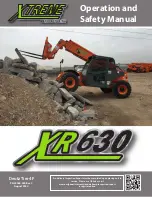
OPERATING PROCEDURES
NARROW AISLE
37
8.
Watch clearances, especially
forks, mast, overhead guard and
tailswing. A lift truck is designed to
perform a wide variety of functions
within limited space. The operator
must be aware that the forks can
sometimes extend beyond the
front of the load. If the forks extend
beyond the load, the operator can
hit an object or lift another load.
9.
Avoid bumps,
holes, slick spots
and loose materials
that may cause the
lift truck to swerve
or tip. If unavoid-
able, slow down.
10.
Do not pass another lift truck traveling in the same
direction at intersections, blind spots or at other dangerous
locations.
11.
Stay away from the edge of the road. Keep the wheels
of the lift truck, particularly the steer wheels, on the
roadway. If the wheels are allowed to run off the edge of the
travel surface onto soft ground, the lift truck can tip over.
12.
Under all travel conditions,
operate the lift truck at a speed
that will permit it to be brought to
a stop in a safe manner.
Highway Trucks, Railroad Cars and Docks
Before operating in a highway truck or railroad car, observe
the following:
Property of American Airlines








































